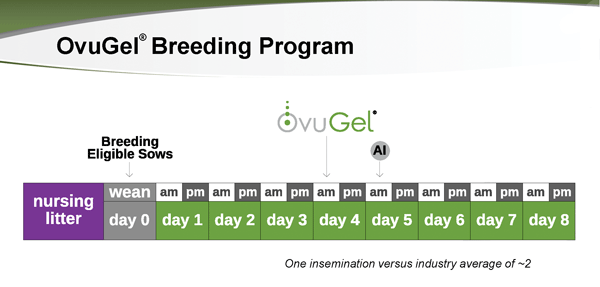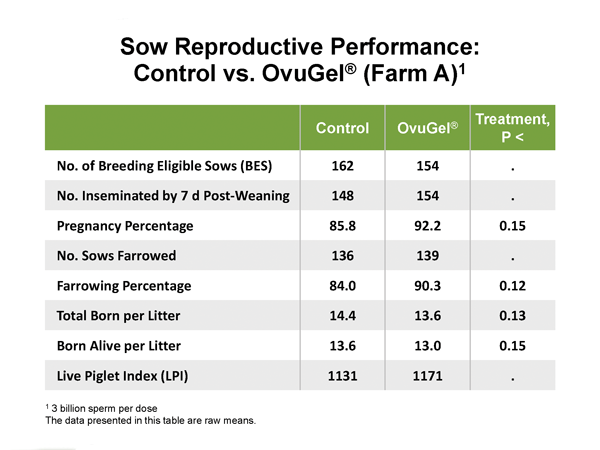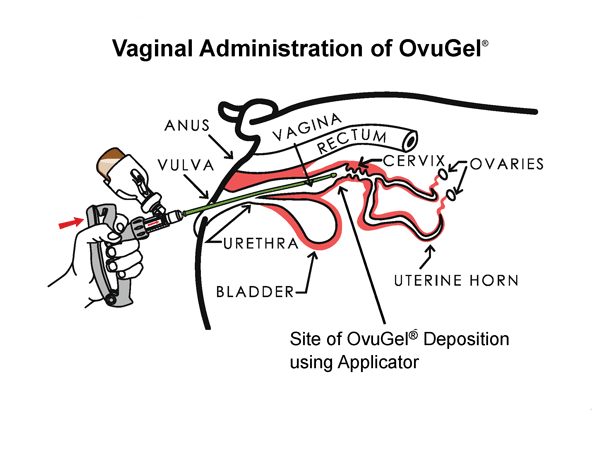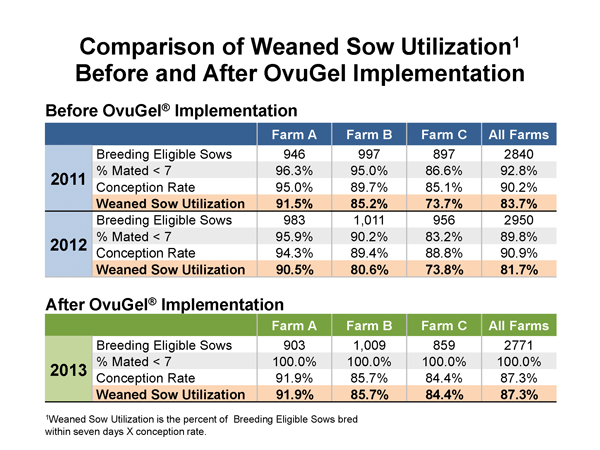Ovulation synchronization product is another step forward for reproductive efficiency.
December 20, 2013

Significant advances in reproductive performance in the breeding herd are hard to come by in modern-day pork production systems. The widespread adoption of artificial insemination gave commercial pork producers greater access to genetically superior maternal and terminal lines, nudging sow reproductive, nursery and finishing performance higher and chipping away at the feed required to produce a pound of gain.
OvuGel, introduced by JBS United Animal Health at World Pork Expo in June, offers a rare opportunity to capture more genetic value and continue to move performance indicators upward. Primary advantages of the product’s use include synchronizing ovulation of newly weaned sows, single-service insemination, reduced labor and reallocation of the workforce in high-return areas, such as assisted farrowing and day-1 pig care. Reproductive physiologists Rob Knox and Billy Flowers at the University of Illinois and North Carolina State University, respectively, conducted much of the early work to refine dosage and to better understand the mode of action for the hormone in OvuGel.
The near-clear gel product contains triptorelin acetate, more formally known as a gonadotropin releasing hormone (GnRH) agonist, which stimulates release of luteinizing hormone (LH) and resultant ovulation — mimicking the cascade of physiological events that occur in newly weaned sows — albeit in a tighter time frame.
Research Groundwork
Early on, Knox and his graduate students studied the timing of triptorelin application and measured ovulation and fertility levels at the university research farms.
The next step was to test the hormone in a commercial setting. Knox and students conducted around-the-clock transrectal ultrasound readings in a high-producing, 5,500-sow herd in Illinois. Ultrasound measurements were taken in eight-hour increments to gain a clearer picture of how follicles mature and, subsequently, when ovulation occurs.
Sows were weaned on Thursday mornings — a common time frame in modern pork production systems. “We needed to know when the sows were expressing heat, the impact of the synthetic hormone treatment and when ovulation occurred,” Knox explains.
“We collected a great deal of day-3 [postweaning] ultrasound data — typically before sows expressed heat. We could see how their follicles were developing, and we could almost predict whether a sow was fertile by Sunday,” he says.
“Assessment of estrus and follicle data led the team of researchers to administer treatment on Monday morning — 96 hours after weaning. Any sow that was going to respond to the hormone would normally come into heat by Monday, Tuesday, Wednesday or Thursday at the latest. By the time a sow expresses estrus, it is the equivalent to a trigger that has already been pulled, and the bullet has left the chamber of the gun,” Knox points out.
With Thursday morning weaning, it is quite likely that some sows will be in estrus by Sunday morning. “That’s OK,” he notes. “In our early studies, we administered triptorelin at the onset of estrus with no detrimental effects on fertility, but no great advantage, either. However, when OvuGel is given ahead of the majority, the animals that were probably going to express estrus on Tuesday and Wednesday, and perhaps even Thursday, are pulled forward,” he explains.
How OvuGel Works
A 2-ml dose, dispensed with a commercially available, multidose applicator, deposits the OvuGel in a sow’s vagina 96 hours (four days) after weaning. The synthetic peptide synchronizes ovulation and allows all sows to be bred 24 hours later (Figure 1).

“OvuGel serves as an agonist of gonadotropin-releasing hormone (GnRH), which in its synthetic form is a more potent and longer-lasting form of natural GnRH. The natural form has a very short half-life,” Knox explains.
“When OvuGel is absorbed into the bloodstream, it reaches the brain and acts at the pituitary level to cause an LH surge to occur. That’s what the drug is designed to do,” he adds.
“In a normal physiological event, as follicles grow larger on the ovary, the follicles produce more and more estrogen. When estrogen reaches a particular threshold in the bloodstream, the frequency of GnRH from the hypothalamus increases and that, in turn, causes a massive release of LH into the bloodstream, which triggers ovulation of the follicles. The large surge of LH reaching the ovaries causes changes in the large follicles that are present. This cascade of events takes time for those changes and ovulation to occur,” Knox explains.
The Illinois researchers’ transrectal ultrasound images showed that the first significant population of large follicles are present and sows begin to show estrus at 96 hours postweaning. This helped pinpoint the best time to administer the synthetic hormone treatment.
“Our ultrasound work showed a strong relationship between early onset of estrus and delayed ovulation time. There are lots of documented studies showing sows that return to estrus early ovulate later, and sows that return to estrus later tend to ovulate earlier. Therefore, estrus is not the perfect predictor of ovulation. If we can eliminate this imperfect indicator, I think we can get down to fixed-time insemination,” Knox continues.
With synchronized ovulation, fixed-time insemination would eliminate the need for heat detection and allow breeding herd managers to tighten breeding periods and focus on using better sires more effectively. While heat detection isn’t necessary with OvuGel, boar stimulation is recommended.
“I think OvuGel could be a wonderful tool in reducing variation in ovulation — especially pulling the tail-enders forward,” Knox adds.
Success with OvuGel
Stephen Webel, director of reproductive research and development at JBS United Animal Health, Sheridan, IN, has been studying estrus and ovulation in sows and gilts for more than four decades. For the last 10 years, he has focused on compiling the documentation needed for Food and Drug Administration (FDA) approval of OvuGel.
The FDA process begins with documenting chemical and manufacturing controls, formulations and product stability before clinical trials can begin. The next steps include documenting product effectiveness, animal safety, human and food safety and, finally, meeting environmental impact guidelines. There is no withdrawal period and no human food safety limitations associated with the product. FDA approved OvuGel in September 2012.
Prior to the World Pork Expo rollout of OvuGel, six field trials had been completed and five more were initiated. Brentwood Farms, a 2,600-sow, breed-to-wean unit near Crawfordsville, IN, has been instrumental in demonstrating the effectiveness of the product in a commercial setting; 115-120 sows are weaned weekly, with 100-105 “breeding eligible” sows moved to the breeding-gestation barn after culls are removed. “Everything is triggered by weaning,” Webel explains. “When you take away the nursing piglets, a cascade of events begins in the sow.”
Before OvuGel, the common procedure at Brentwood Farm was to wean sows on Thursday and provide daily boar exposure from weaning to insemination, explains Manuel Enrique, breeding herd manager. Heat checking began on Day 4, with estrus recorded and sows inseminated each day they were in standing heat. Two technicians spent 1½ to 2 hours/day inseminating sows on Days 4, 5 and 6 after weaning, with a few sows bred on Day 7. Most sows were inseminated at least twice.
Table 1 shows a side-by-side comparison of OvuGel-treated sows vs. typical sows (controls) managed and bred utilizing standard heat detection and artificial insemination methods. Sows that failed to display heat by Day 7 were moved to an “opportunity row,” where they received daily boar exposure, including weekends, and were bred when/if they expressed estrus. With the OvuGel breeding program, timing is key, reiterates Webel. A common schedule is to wean sows between 7 and 11 a.m. on Thursday. Boar exposure is the same as conventional systems, although actual heat checking is unnecessary.

On Monday morning (7-11 a.m.), four days (96 hours) after weaning, sows receive a 2-ml dose of OvuGel. The patented carrier gel delivers a miniscule amount of triptorelin acetate, the GnRH analog, which enhances its release across the vaginal epithelium. “The viscosity of the gel is very important,” Webel emphasizes.
The cross-section diagram in Figure 2 shows proper OvuGel administration, with the infusion tube tilted slightly upward to avoid the urethra. If a slight resistance is felt, the infusion tube has bumped against the cervix and should be withdrawn about ½ in. The 2-ml dose is discharged in the vagina, the infusion tube withdrawn, and the disposable protective sheath removed and replaced before moving on to the next sow. Each administration takes just 20-30 seconds to complete

Adhering to the precise schedule, on Tuesday morning between 7 and 11 a.m. (24 hours after treatment and 120 hours after weaning), sows are exposed to heat-check boars, and then inseminated with one normal dose of semen (3 billion sperm/dose) regardless of estrus status.
With conventional AI, a standard catheter deposits the semen in the cervix, and boar stimulation helps draw the semen into the uterus. OvuGel-treated sows do not have to exhibit standing heat to be inseminated, Webel continues. Post-cervical insemination (PCAI) is delayed about 30 minutes after boar exposure to allow sows displaying standing heat to “go refractory,” allowing the cervix to relax a bit. The PCAI catheter is placed at the entry of the cervix. Then the smaller, inner cannula is extended through the cervix and the semen deposited, taking just a few seconds.
“PCAI goes hand in hand with OvuGel. It only requires a limited amount of training for experienced AI technicians,” Webel adds.
Bob Altman, JBS United Animal Health technical services manager, has been organizing sow performance records based on weaned sow utilization (WSU), a reflection of the breeding eligible sows (non-culls) bred within seven days after weaning multiplied by conception rates.
Table 2 shows corresponding WSU values for a nine-week period in 2011 and 2012 (without OvuGel), with breeding eligible sows treated with OvuGel and mated in 2013. Weaned sow utilization was comparable in farms A and B in this comparison, but Farm C clearly benefited from the OvuGel treatment.

“This data fits perfectly for a comparison of OvuGel-treated sows vs. non-treated sows, since all of the weaned sows are mated rather than just those detected in heat [non-treated],” Webel notes.
Protocols and Logistics
Weaning sows is often dictated by transport availability, and receiving protocols at nurseries and grow-finishers.
“Trucking logistics are often established; we don’t have a lot of wiggle room and biosecurity protocols must be followed,” Webel emphasizes. “Plus, the farm staff needs to get sows out of the farrowing crates so they can wash and reload farrowing rooms.”
While the multidose applicator delivery system is easy to use, post-cervical AI takes a little getting used to, Webel explains.
Therefore, JBS United has launched “a very controlled introduction” of OvuGel that includes training from its team of six technical services staff members. “We want to make sure they understand that timing is very critical with this product,” he continues.
Boar Semen Handling
Another limiting factor can be boar semen delivery. “OvuGel is going to work 99% of the time, but artificial insemination has to be done properly, and boar semen must be top quality and handled properly on the farm,” Webel emphasizes.
“You have to have an appropriate semen receiving vessel. It is best if semen delivery can be made directly into the storage unit without having someone there waiting for it to arrive,” he says. Brentwood Farm has a double-door cooler/refrigerator placed just inside the entry door where the delivery person can place semen directly without entering the facility, so the staff can move it to the regular semen storage cooler later. “If you’re breeding 100 sows a week, the cost of a semen cooler is minimal,” he points out.
Webel recommends scheduling semen delivery for the day OvuGel will be administered, thus ensuring it is available 24 hours later — at insemination time.
More Reproductive Technologies
Donning his Extension adviser’s hat, Knox acknowledges that commercial producers have improved fertility in the sow herd dramatically the last 20 years.
“I think we are reaching close to the pinnacle of fertility in some herds. It’s not unusual to see a 92% farrowing rate in a large herd. They use all of the technologies available: estrous detection, pooled semen, multiple inseminations,” he observes.
“Heat checking can be a wonderful talent. It’s the best tool we have, but it’s an imperfect tool and it can be physically challenging [i.e., reaching over gates to put pressure on sow’s back, etc.]. I like the ability to synchronize ovulation in a group that would otherwise be spread out.
“We have some technologies, such as intrauterine and/or deep-uterine insemination, where lower doses of fresh or frozen boar semen can be used. Because of its lower fertility, frozen semen can’t be used the same way as fresh, liquid semen, so timing becomes more important. I don’t see any way to access these technologies unless we can get down to a single insemination,” he adds.
Economics of OvuGel
The retail price of OvuGel is $6.75/dose, excluding the multidose, repeating syringe, which costs about $20. However, each syringe should last for several thousand doses, Webel says. Disposable sheaths cost approximately 20 cents each.
“The value of OvuGel is more about genetic merit, using better boars and their impact on finishing performance — values that far outweigh the cost of OvuGel or a dose of boar semen,” Webel stresses. “With all sows bred once, at the same time, you can also add in the value of reallocated labor and the efficiencies associated with tighter farrowing groups, better assisted farrowing schedules and improved day-1 pig care.
“This product could change the whole scope of what we are doing on sow farms. Beyond single, fixed-timed inseminations, I am more interested in how we reorganize gestation rooms by eliminating the ‘hard-head, opportunity’ sows, how it could greatly change farrowing management, uniformity of pigs at weaning and the impact that could have on nursery and finisher performance,” Webel concludes.
Dale Miller is former editor of National Hog Farmer and is a freelance writer in Hampton, MN.
You May Also Like


